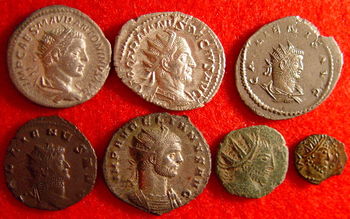
Antoninianus
Encyclopedia

Coin
A coin is a piece of hard material that is standardized in weight, is produced in large quantities in order to facilitate trade, and primarily can be used as a legal tender token for commerce in the designated country, region, or territory....
used during the Roman Empire
Roman Empire
The Roman Empire was the post-Republican period of the ancient Roman civilization, characterised by an autocratic form of government and large territorial holdings in Europe and around the Mediterranean....
thought to have been valued at 2 denarii
Denarius
In the Roman currency system, the denarius was a small silver coin first minted in 211 BC. It was the most common coin produced for circulation but was slowly debased until its replacement by the antoninianus...
. It was initially silver, but was slowly debased
Debasement
Debasement is the practice of lowering the value of currency. It is particularly used in connection with commodity money such as gold or silver coins...
to bronze
Bronze
Bronze is a metal alloy consisting primarily of copper, usually with tin as the main additive. It is hard and brittle, and it was particularly significant in antiquity, so much so that the Bronze Age was named after the metal...
. The coin was introduced by Caracalla
Caracalla
Caracalla , was Roman emperor from 198 to 217. The eldest son of Septimius Severus, he ruled jointly with his younger brother Geta until he murdered the latter in 211...
in early 215
215
Year 215 was a common year starting on Sunday of the Julian calendar. At the time, it was known as the Year of the Consulship of Laetus and Sulla...
and was a silver coin similar to the denarius except that it was slightly larger and featured the emperor wearing a radiate crown, indicating that it was valued at twice as much. Antoniniani depicting females (usually the emperor's wife), featured the bust resting upon a crescent moon.
But even at its introduction its silver content was only equal to 1.5 denarii. This helped create inflation - people rapidly hoarded the denarii, while both buyers and sellers recognised the new coin had a lower intrinsic value and elevated their prices to compensate. Silver bullion supplies were running short since the Roman Empire was no longer conquering new territory, and because a series of soldier emperors and rebels needed coin to pay their troops to buy loyalty. So each new issue of the antoninianus had less silver in it than the last, and each contributed to inflation. By the late third century the coins were almost entirely made of bronze
Bronze
Bronze is a metal alloy consisting primarily of copper, usually with tin as the main additive. It is hard and brittle, and it was particularly significant in antiquity, so much so that the Bronze Age was named after the metal...
from melted down old coins like the sestertius
Sestertius
The sestertius, or sesterce, was an ancient Roman coin. During the Roman Republic it was a small, silver coin issued only on rare occasions...
. Vast quantities were being produced, with a large proportion of the stocks being contemporary forgeries, often with blundered legends and designs. Individual coins were by then practically worthless and were lost or discarded by the millions. Today the coins are extremely common finds. The situation was not unlike the hyperinflation
Hyperinflation
In economics, hyperinflation is inflation that is very high or out of control. While the real values of the specific economic items generally stay the same in terms of relatively stable foreign currencies, in hyperinflationary conditions the general price level within a specific economy increases...
of the Weimar Republic
Weimar Republic
The Weimar Republic is the name given by historians to the parliamentary republic established in 1919 in Germany to replace the imperial form of government...
in 1920s Germany
Germany
Germany , officially the Federal Republic of Germany , is a federal parliamentary republic in Europe. The country consists of 16 states while the capital and largest city is Berlin. Germany covers an area of 357,021 km2 and has a largely temperate seasonal climate...
when paper money was printed in reckless abundance. The coin ceased to be used by the end of the third century when a series of coinage reforms attempted to arrest the decline by issuing new types.
Modern numismatists use this name for the coin because it is not known what it was called in antiquity. The name was given to it because an ancient Roman document called the Historia Augusta (of generally low reliability) refers to silver coins named after an Antoninus on several occasions (several Roman emperors in the late second and early third centuries bore this name among others). Because Caracalla's silver coin was a new issue, and he had taken Antoninus as part of his imperial name, an association was made with it, and although the association is certainly false, the name has stuck.

